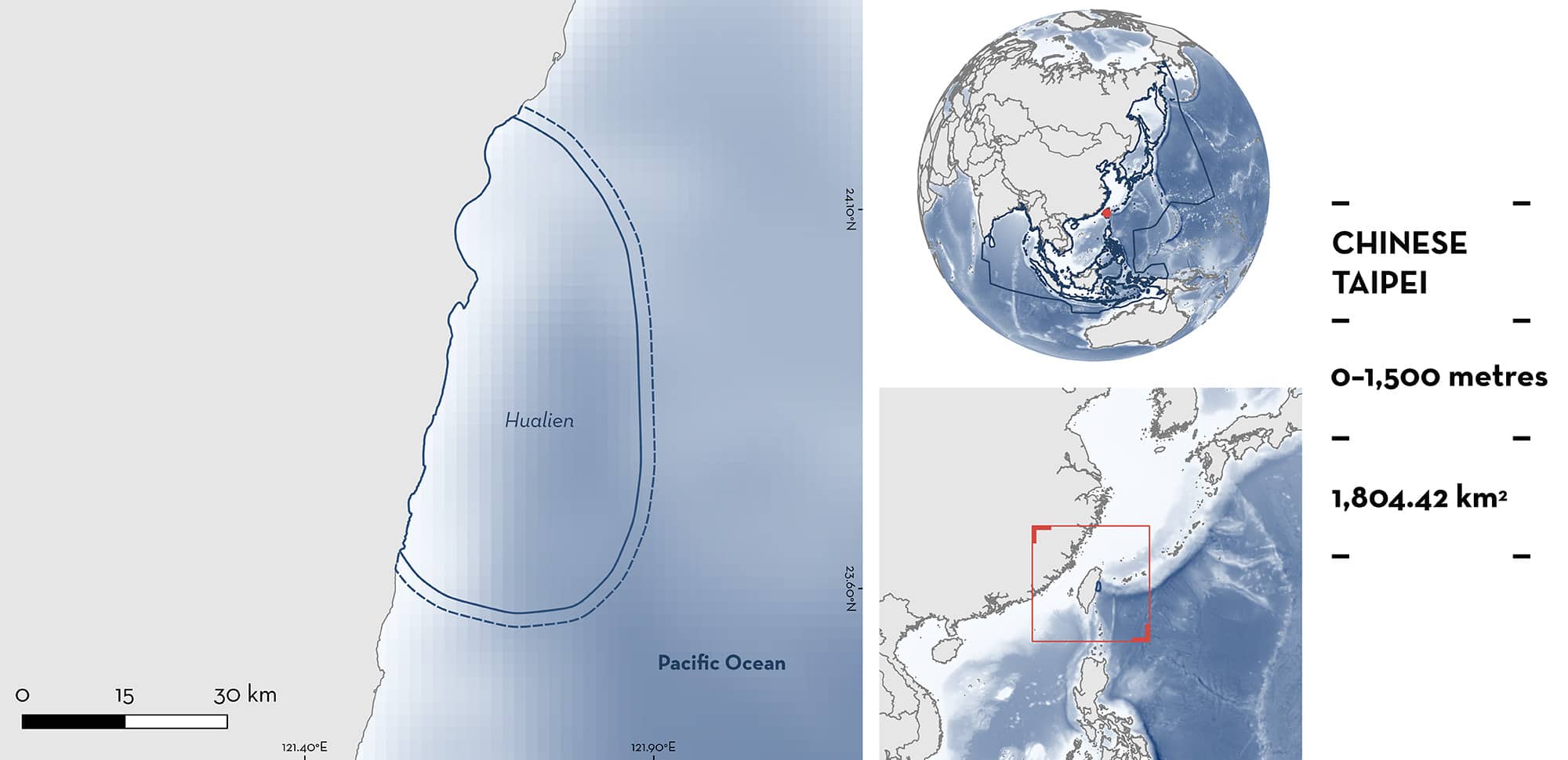ISRA FACTSHEETS
ISRA FACTSHEETS
ASIA REGION
Hualien
Summary
Hualien is located off the east coast of Taiwan in the Northwest Pacific. The area has a fault-line type coastline, with depths reaching over 1,000 m just a few kilometres offshore. The ocean currents affecting this area include the Kuroshio Current, the northeast and southwest monsoon currents, and upwelling currents. The area is characterised by deep pelagic waters with rock, sand, and gravel substrates. The area overlaps with the Shuei-lian Marine Protected Area. Within this area there are: feeding areas (Megamouth Shark Megachasma pelagios).
Download factsheet
Hualien
DESCRIPTION OF HABITAT
Hualien is located off eastern Taiwan in the Northwest Pacific. The shelf is narrow, with depths reaching over 1,000 m just a few kilometres offshore. Hualien supports several types of coastal and marine habitats. The main habitats are rocky, sandy, and gravel substrates, and small parts on the shelf are coral reefs. The area is primarily fed by three major river systems, the Hualien, Siouguluan, and Liwu Rivers. The combined annual discharge volume is ~9,323 million cubic meters (Water Resources Agency 2023).
The marine currents affecting the area include the Kuroshio Current, the Northeast Monsoon Current, the Southwest Monsoon Current, and upwelling currents (Tang et al. 2000). The Kuroshio is the most important current off eastern Taiwan, flowing northward along the shelf. It transports warm water from the tropics to higher latitudes and extends down to 1,000 m depth in some parts off eastern Taiwan (Hsin et al. 2008).
The area overlaps with the Shuei-lian Marine Protected Area.
This Important Shark and Ray Area is benthopelagic and is delineated from inshore and surface waters (0) to 1,500 m based on the bathymetry of the area and the global depth range of the Qualifying Species.
CRITERION C
SUB-CRITERION C2 – FEEDING AREAS
Hualien is an important feeding area for one shark species.
Megamouth Sharks are seasonally (March–June) caught in gillnets in this area, with stomach content analyses showing that they feed mostly on krill and jellyfishes (Yu 2022; CJ Yu unpubl. data 2023). Stomach contents were examined from 19 individuals caught between 2013–2019 in Hualien. These ranged from 352–615 cm total length and included five juveniles and 14 adults (13 females; 6 males). For five specimens the stomach contents could not be identified. Euphausiid krill were identified in all other 14 stomach contents and had a high Ranking Index (RI) of 33%. Jellyfishes had a higher RI of 67% but wet weight was used in the analyses, meaning that much of the jellyfish weight was water. Krill and jellyfishes are typical prey items of Megamouth Sharks based on sporadic observations elsewhere in the world (Watanabe & Papastamatiou 2019). Both prey items are abundant in Hualien. Euphausiid krill are more abundant in summer than in winter in the area (Hsieh et al. 2016) and the fishers capturing Megamouth Sharks are targeting Ocean Sunfish (Mola mola) and Sharptail Mola (Masturus lanceolatus) (CJ Yu pers. obs. 2023) whose diets include jellyfishes (Nakamura & Sato 2014). This indicates that this area supports the prey that attracts Megamouth Sharks to the area. Individuals are captured as incidental catch in large-mesh (90 cm mesh size) drift nets set at ~10–140 m depth at night (CJ Yu pers. obs. 2023). This supports the idea that Megamouth Sharks vertically move into shallower water at night (Nelson et al. 1997) to feed on euphausiids and jellyfishes. More than half of all Megamouth Shark sightings (n = 264) recorded worldwide are from Hualien (Yu et al. 2021), with records extending to close to the coast (Hsu et al. 2022), highlighting the global importance of this area for this species.
Download factsheet
SUBMIT A REQUEST
ISRA SPATIAL LAYER REQUEST
To make a request to download the ISRA Layer in either a GIS compatible Shapefile (.shp) or Google Earth compatible Keyhole Markup Language Zipped file (.kmz) please complete the following form. We will review your request and send the download details to you. We will endeavor to send you the requested files as soon as we can. However, please note that this is not an automated process, and before requests are responded to, they undergo internal review and authorization. As such, requests normally take 5–10 working days to process.
Should you have questions about the data or process, please do not hesitate to contact us.


